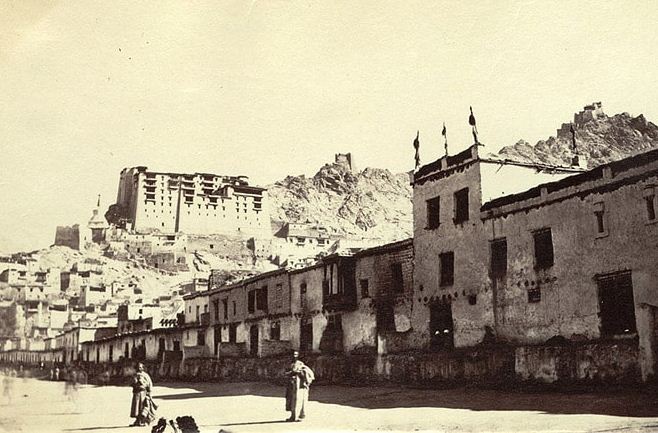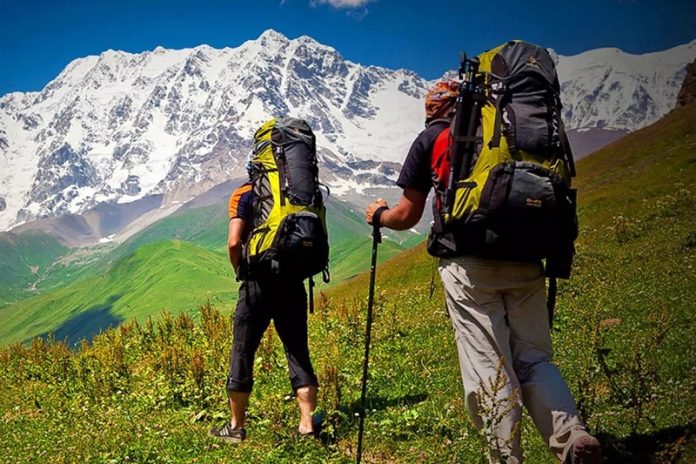By Journey Man
Ladakh offers some wonderful and exciting trekking experiences to the visitors. This Himalayan region is a haven for those seeking adventure in the lap of mountains and peaks. There are many trekking options in Ladakh, which vary in difficulty and duration.
The best time for trekking in Ladakh is from May to October. However, some treks are possible only from early July due to heavy snowfall on the mountain passes in winters. The onset of winter marks the beginning of two treks that are organised from January to March every year in Ladakh: the Chadar trek on the frozen Zanskar river and the Snow Leopard trek.
Here are some Famous Trekking Places
Markha valley trek
The Markha valley trek in the Hemis National Park is the most popular trek in Ladakh. The Markha valley runs parallel to the Indus valley, wedged between the snow-clad Stok Kangri massif to the north and the Zanskar range to the south. During this trek, you will see breathtaking mountain scenery, wild animals and small isolated villages surrounded by green barley fields. You will have the opportunity to stay in homestays in these villages and discover the way of life of the local people.
The trek takes 6 to 8 days to complete depending on the starting point. The Markha valley can be reached from two different routes: one from Spituk and the other from Chilling. The trek from Spituk is the longest option. It crosses 2 passes, Ganda La (4961m) and Kongmaru La (5260m), before reaching Hemis where the trek ends. Those who don’t have enough time and those looking to avoid the Ganda La pass could start the trek from Chilling, an easier and shorter option.
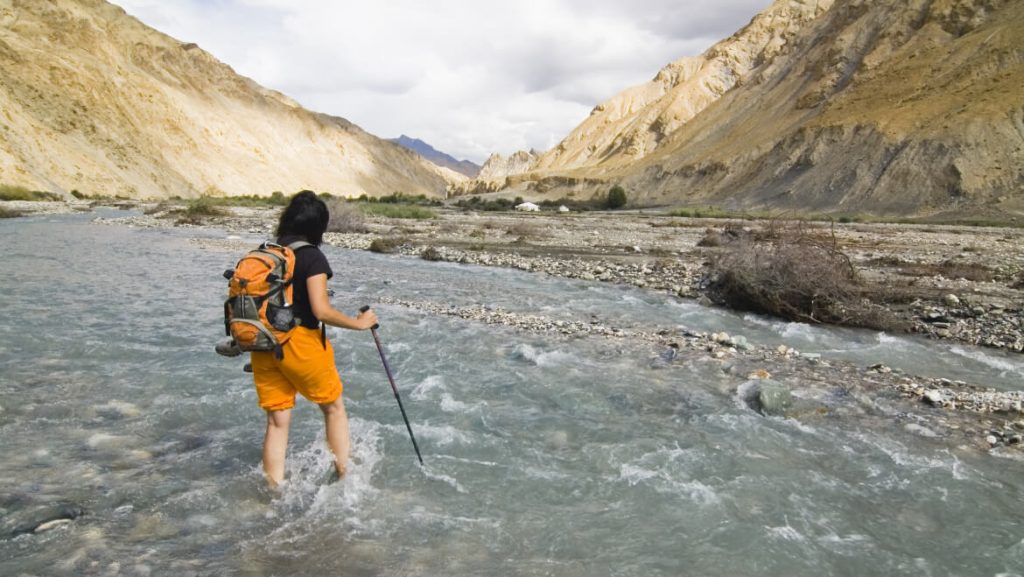

Best time: end of April to beginning of October
Duration: 6 to 8 days
Nubra Valley trek
Nubra valley trek passes through Khardung La the highest motorable road in the world 18,380 feet. After trekking through the pass, you will see Khardung village, Khalser and Deskit. The camel trip can be done from Diskit to Hunder village for 2 hours. Hundar village has a small monastery, located on the ancient Silk Route.
The trek from Phyang to Hunder connects the Indus valley to the Nubra valley. It follows an ancient trade route which was part of the old Silk Road network stretching from India to Central Asia. The highest point on this off-the-beaten-path trek is the Lasermo La pass (5438m) which is covered with ice and snow even in summer. From the pass, there is a wonderful panorama of the Karakoram range. This trek is done in 5 days.
Best time: mid-July to end of September
Duration: 5 days
Rumtse to Tso Moriri trek
This is one of the most beautiful and wild treks in Ladakh. This week-long trek takes you through the high-altitude plateau of Changthang (Rupshu). The region has distinctive landscapes and you will see mountains of different textures and colour while crossing 6 passes above 5,000 metres. Even though Ladakh is a cold desert, it has some beautiful lakes to offer to the visitors. During this trek, you will have the chance to discover the scenic Tso Kar and Tso Moriri lakes.
This trek goes quickly to very high altitude; the first night in Kyamar is at 4,500 metres and the next 6 days are always at an elevation between 4,500 and 5,500 metres. Therefore, it is important to be well-acclimatized to the altitude before starting the trek.
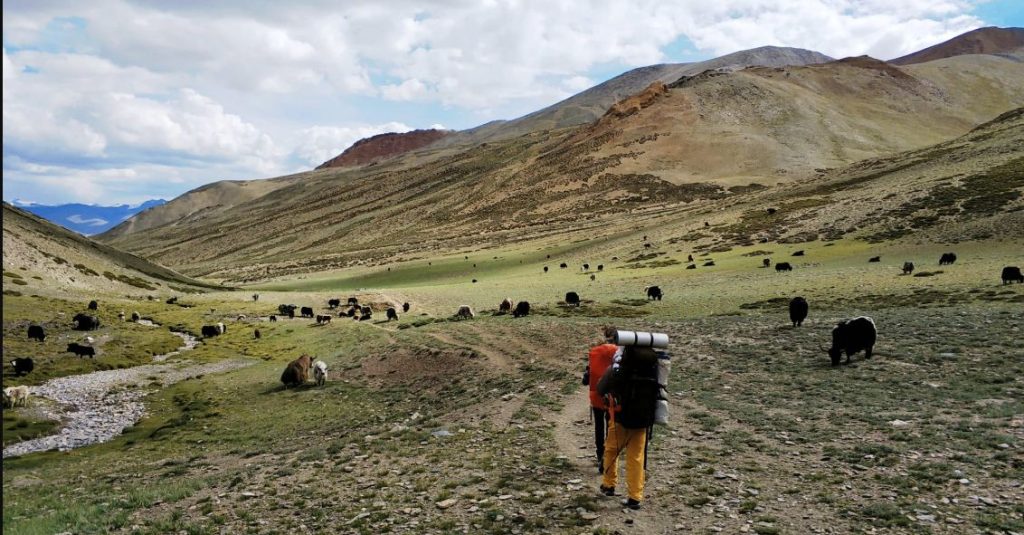

Best time: mid-June to mid-October
Duration: 7 days
Sham valley trek
Often called the “baby trek” because of the easy nature of the trek, there is no doubt the Sham valley trek offers some picturesque views to the trekkers. If you are looking for an easy trek suited for your kids, then this is the one for you. It never goes above 4000 metres and it can be done throughout the year.
The trek passes through many small villages where you can spend the nights in homestays and enjoy the authentic local cuisine prepared by the families. Some ancient and famous monasteries at Likir, Rizong, Temisgam, Basgo and Alchi could be visited during and after the trek.
Best time: all year round
Duration: 3 days
Stok Kangri climb
The Stok Kangri peak is the perfect objective for a first mountaineering experience in the Himalayas and for those looking to cross the 6,000-metre barrier. Even though the peak is not technical, climbers still have to use all the mountaineering gear such as crampons, axe, rope, etc. The expedition guide will provide a short introductory course on how to use the equipment during the day of acclimatization at the base camp.
The Stok Kangri expedition is hard on your body and mind but you will realise it was worth it when you reach the summit and enjoy the incredible view of the surrounding mountains. The expedition can be started from Stok or from Spituk, or it can be combined with the Markha trek.
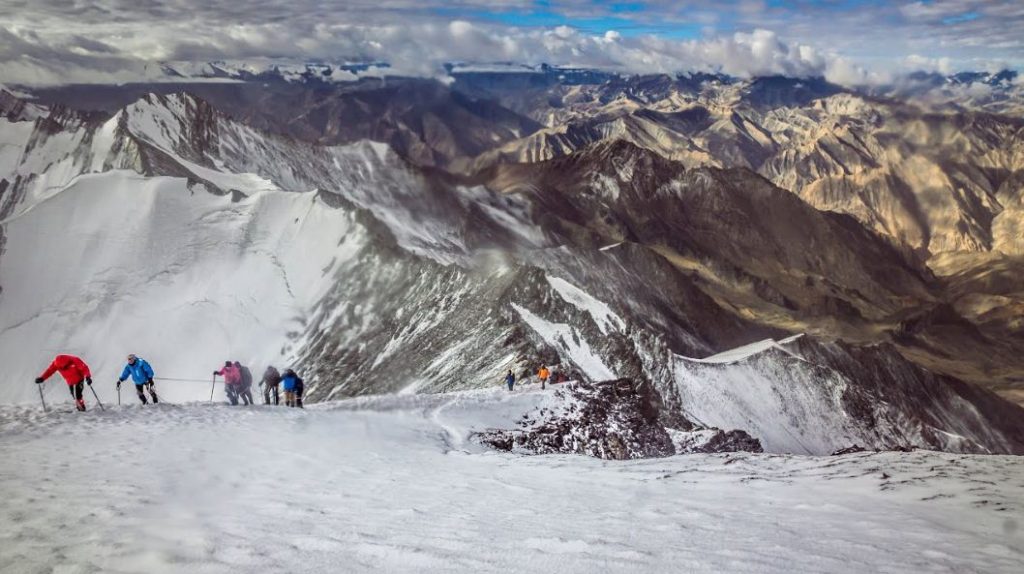

Best time: mid-June to end of September
Duration: 4 to 6 days
Spituk to Stok trek
The trek from Spituk to Stok is for those who are short on time but want to experience a nice trek in Ladakh inside three days. Make an auspicious start to the trek by stopping at the Spituk monastery, an 11th-century monastery belonging to the Gelugpa sect.
After crossing the Indus river, you will reach Zingchen from where a two-hour hike will take you to Rumbak. It is a nice village with whitewashed houses surrounded by barley and mustard fields. You can stay in a homestay in this village. After spending the night at Rumbak, ascend to the top of Stok La pass from where you will get an amazing view of colourful snow-clad mountains. The winding way down to the village of Stock will leave you with some everlasting memories.
Best time: beginning of June to end of October
Duration: 3 days
Lamayuru to Alchi trek
The western part of Ladakh is not only famous for its centuries-old monasteries but also the Lamayuru to Alchi trek. This five-day trek is dotted with two tough passes – Kongskil La (4948m) and Stalpi La (5153m) – and will push your limit to the maximum, but you will be rewarded with dramatic mountain scenery. Spend nights at homestays in remote villages if you want to experience local culture closely. Also, visit monasteries before or after the trek.
Best time: mid-June to mid-October
Duration: 5 days
Zanskar trek
Zanskar is one of the most remote areas in Ladakh and that is where its beauty lies. This 10-day trek from Padum to Lamayuru is the best trek in Zanskar that covers ancient monasteries, small villages and the beautiful landscapes of the Zanskar range.
This has one of the most isolated monasteries in Zanskar that was built in the 15th century. Zanskar offers sceneries of exceptional beauty, mountains in almost every colour and also its unique culture to the trekkers. The trek is peppered with three main passes: Hanuma La (4724m), Singge La (5009m) and Sir Sir La (4832m).
Best time: mid-June to beginning of October
Duration: 10 days
Snow Leopard trek
Ladakh is home to one of the rarest wild cats in the world: the majestic snow leopard. The Snow Leopard trek is organised in the Hemis National Park in the month of February and March. The Hemis National Park is home to snow leopards and many other species of mammals such as Tibetan wolves, Asiatic ibex, blue sheep and Ladakh urials.
Spotting the elusive snow leopard in sub-zero temperatures is certainly not easy. Patience is key to wildlife expeditions like these. After hours and sometimes days of waiting, many have sighted snow leopards in their binoculars and even returned home with images of the big cat captured on their cameras.
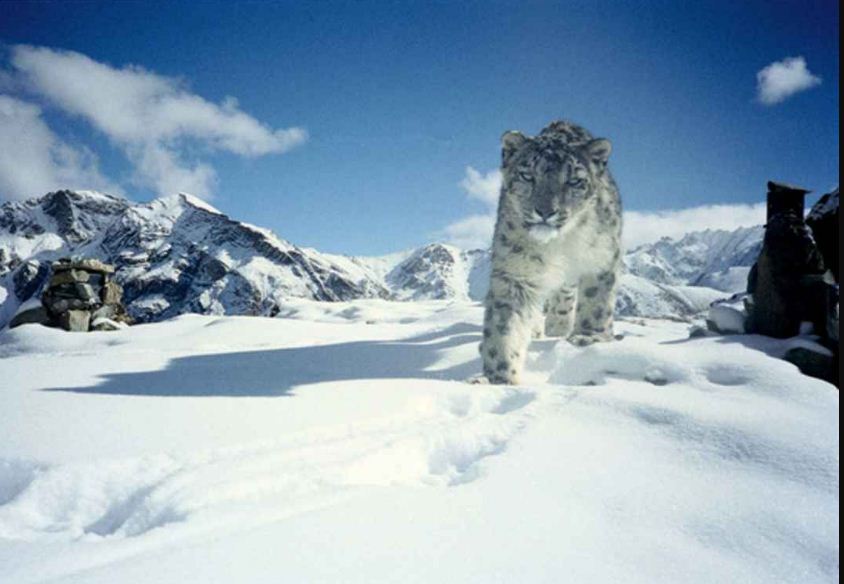

Best time: March
Duration: 8 days
Chadar frozen river trek
As Zanskar remains cut off from the rest of the country in winter due to heavy snowfall, the Chadar route acts as a lifeline.
Over the years, the Chadar trek has become the “next big thing” in Ladakh and it is easy to see why. Walking on the frozen Zanskar river that stretches 105 km in mind-numbing temperatures (-25 to -35 degrees) tests the limit of the trekkers. Also, there are not too many treks that pass through gorges with frozen waterfalls and that follow a trail of ice that turns into a mirror for the sky. The Chadar trek has received coverage in the form of documentaries, especially in the BBC’s 2011 series called “Human Planet”.
Best time: January-February
Duration: 9 days
A BRIEF HISTORY
Leh (Ladakh) was known in the past by different names. It was called Maryul or low land by some, Kha-chumpa by others. Fa-Hein referred to it as Kia-Chha and Hiuen Tsang as Ma-Lo-Pho. It is said that the first Immigrants to this land appears to have been the Brokpas from Dadarstan who inhabited the lower reaches of the Indus Valley, popularly known as Sham.
Another wave of Immigrants who came from Karja (Kulu) were the Mons, an Aryan type, who first settled in Gya and spread to Rong, Shayok, Sakti Tangtse and Durbuk, the area extending from Martselang to Khaltsi.
Gia was the seat of government of the first Mon ruler having been elected by the whole tribe. His kingdom included the villages mentioned above, all of which was inhabited by the Mons people He was known by the title Gazpacho, derived from his being the master of Gia.
Ancient History: The ancient inhabitants of Ladakh were Dards, an Indo- Aryan race. Immigrants of Tibet, Skardo and nearby parts like Purang, Guge settled in Ladakh, whose racial characters and cultures were in consonance with early settlers. Buddhism traveled from central India to Tibet via Ladakh, leaving its imprint in Ladakh.
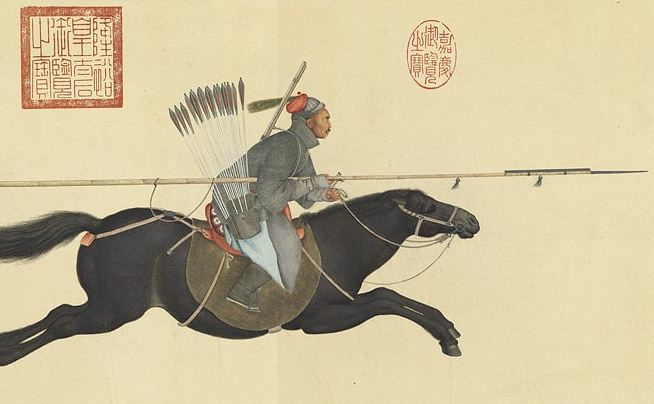

But way before that, rock carvings found in many parts of Ladakh indicate that the area has been inhabited from Neolithic times. Ladakh’s earliest inhabitants consisted of a mixed Indo-Aryan population of Mons and Dards, who find mention in the works of Herodotus, and classical writers as well as the Indian Puranas.
Colonization of Ladakh by Mons and Dards: The first groups of people to settle in Ladakh were Mons and Dards. The Mons migrated from present day Himachal Pradesh while the Dards came from present day Gilgit. Both these people were Aryans by race. The present day Gya-Meru area was the first to be settled.
The Influx of Mongols: The Mongols came from Tibet as nomads and gradually overpowered the Mons and Dards.
Around the 1st century, Ladakh was a part of the Kushan Empire. Buddhism spread into western Ladakh from Kashmir in the 2nd century. The 7th-century Buddhist traveller Xuanzang describes the region in his accounts. Xuanzang’s term of Ladakh is Mo-lo-so, which has been reconstructed by academics as *Malasa, *Marāsa, or *Mrāsa, which is believed to have been the original name of the region.
The Age of the Chos (Princes): Ladakh was divided into several small principalities, each ruled by a Cho or a prince. Upper Ladakh was ruled by the Cho of Gya and Lower Ladakh was ruled by Cho Bagdar Skyabs. Somewhere around the beginning of the 10th century, an army from present day Xinjiang invaded Ladakh. The Cho of Gya asked the ruler of Ngaris, Skyid-Lde Nyimagon for assistance.
Medieval History – The First Kings (10th -11th century): The first king of Ladakh was the ruler of Western Tibetan province of Ngaris Skor Soom, Skyid Lde Nyima Gon who was a direct descendent of Tibetan emperors and one of the two claimants to the Tibetan throne. He divided his domains between his three sons. The eldest son, Pal Gyi Gon received Ladakh, with its capital at Shey, the second son, Tashi Gon received Ngaris, and the third son, Detsug Gon received Zanskar and Spiti.
The First Conquests (1080-1110): Lhachen Utpala, who most probably reigned from 1080-1110, conquered present day Kullu and forced it to pay a tribute and for a time being Ladakh became the paramount power in the Western Himalayas.
The Great Darkness (12th century): The Chronicles of Ladakh, written in the 17th century, leaves a huge gap during the 12th century. Recent research shows that Ladakh was ruled by the Brokpas during this period.
The Adventurer Prince: Crown Prince Rinchen Shah, son of King Lhachen Gyalpo, went to Srinagar, Kashmir and played an active part in the power struggle there. He converted to Islam and reigned as the first Muslim king of Kashmir from 1320-1323.
The Era of Two Kingdoms (1400-1440): Tagspa Bum Lde became the king of Upper Ladakh while his younger brother, Tagspa Bum, became the King of Lower Ladakh. Tagspa Bum Lde outlawed animal slaughter and built the Chamba (Maitreya) Temple in Leh while Tagspa Bum built the Fortress of Tingmosgang.
A Time of Invasions (1440-1550): The period between mid-15th century to mid-16th century is mired in darkness. The official history of Ladakh, The Chronicles of Ladakh, tends to gloss over the failures of the Kings and is riddled with inaccurate dating. But what we can gather from contemporary sources is that Ladakh was invaded repeatedly during this period. The Kashmiris under Sultan Zain-ul-Abidin invaded in the mid-15th century. After that the Uighurs under Mirza Haider repeatedly invaded Ladakh in the first half of the 16th century.
The Founding of the Namgyal Dynasty: In the midst of all this turmoil, the Namgyal Dynasty was founded with its capital at Basgo. This dynasty united both the Upper and Lower Ladakh under one kingdom. It conquered Zanskar and beat back a series of invasions from Kashmir and Kashgar.
The Kingdom at its Greatest Extent (1575-1595): The Kingdom of Ladakh was at its greatest extent under King Tsewang Namgyal. According to The Chronicles of Ladakh, his rule extended from Gilgit in the west to Namrims in the east. He even planned to invade present day Xinjiang, but decided against it, when the people of Nubra pleaded with him not to attack as it would damage the trade between them and Xinjiang.
An Empire Lost (1595-1616): Jamyang Namgyal came to the throne after his brother, Tsewang Namgyal. Areas under Ladakhi rule rose in revolt. To reestablish Ladakhi rule, Jamyang Namgyal invaded Baltistan. He moved up the Losar (New Year) celebrations by 2 months. The Cho (Prince) of Skardu, Ali Mir had united the various principalities of Baltistan under his rule. He defeated the Ladakhi forces and captured the king.
The Ladakhi-Tibeto-Mongol War and its Aftermath (1679-1684): In 1679, Tibeto-Mongol forces under the command of a Mongol prince, Galdan Tsewang, invaded Ladakh. The Ladakhi forces were commanded by Kalon Bangkapa Shakya Gyatso. The two forces clashed in Western Tibet and the Ladakhis were forced back. The two forces again clashed near Chang La. The Ladakhi forces retreated to the fortresses of Basgo and Tigmosgang. The enemy forces captured Leh and besieged the Basgo fortress without success for 3 years.
Modern History: By the beginning of the 19th century, the Mughal Empire had collapsed, and Sikh rule had been established in Punjab and Kashmir. However, the Dogra region of Jammu remained under its Rajput rulers. Raja Gulab Singh, acting under the suzerainty of the Sikh monarch Ranjit Singh, sent his general Zorawar Singh to invade Ladakh in 1834. King Tshespal Namgyal was dethroned and exiled to Stok. Ladakh came under Dogra rule and was later incorporated into the princely state of Jammu and Kashmir under British suzerainty. It still maintained considerable autonomy and relations with Tibet.
